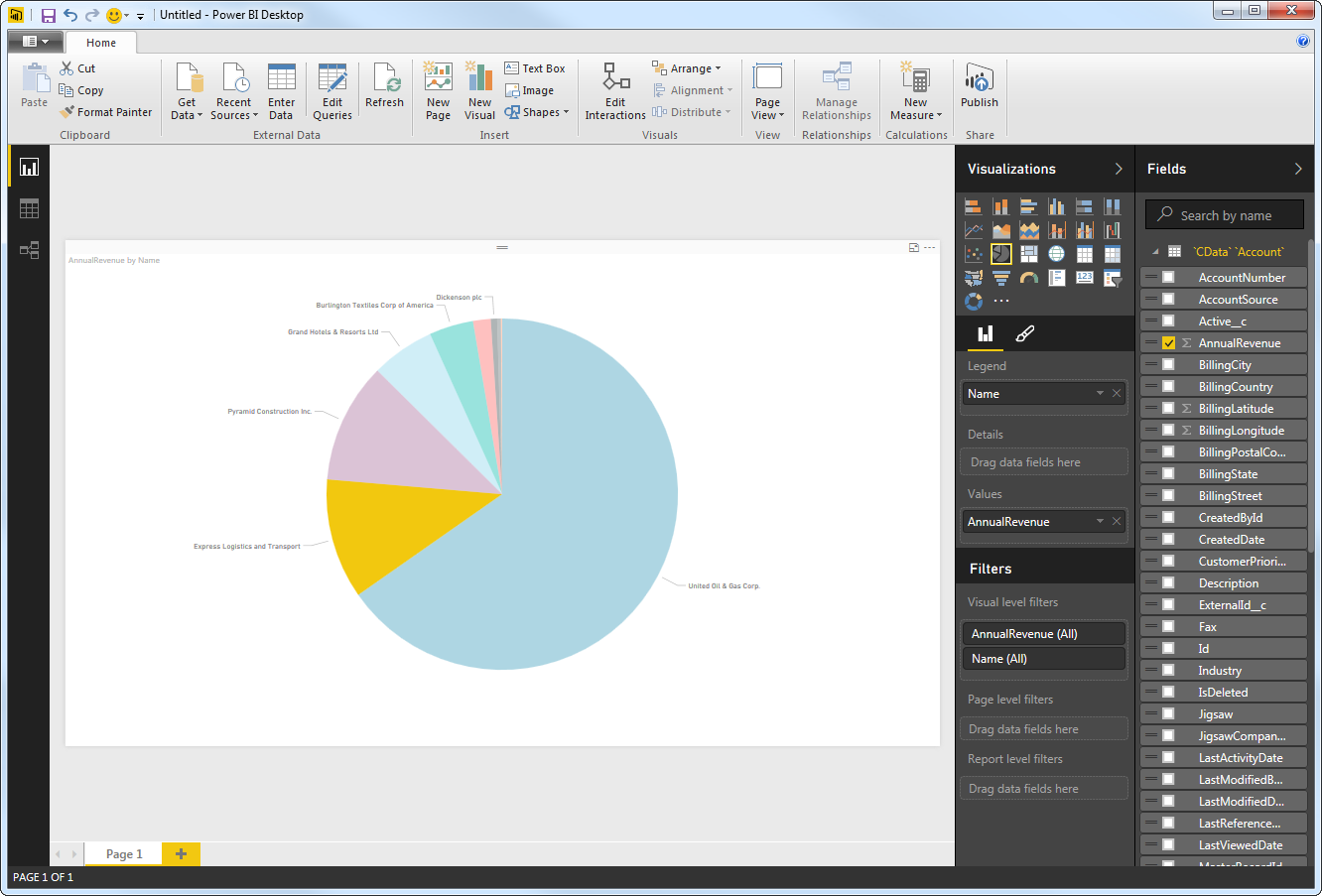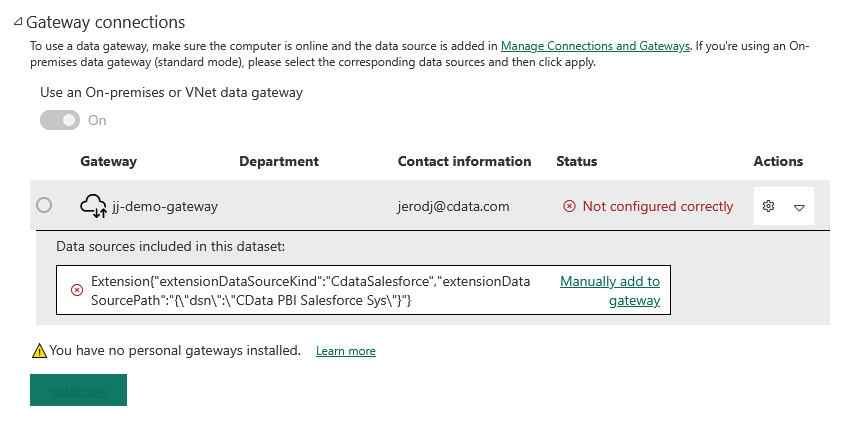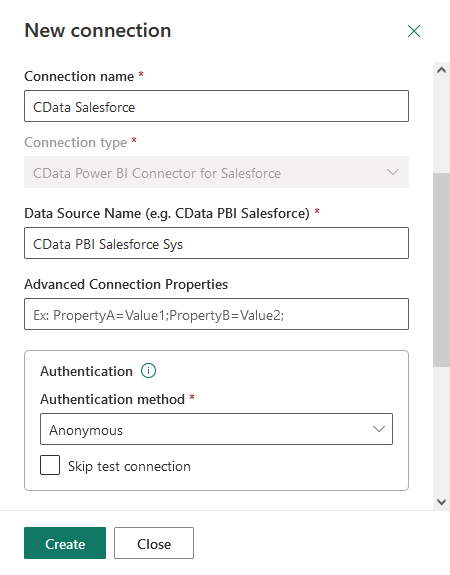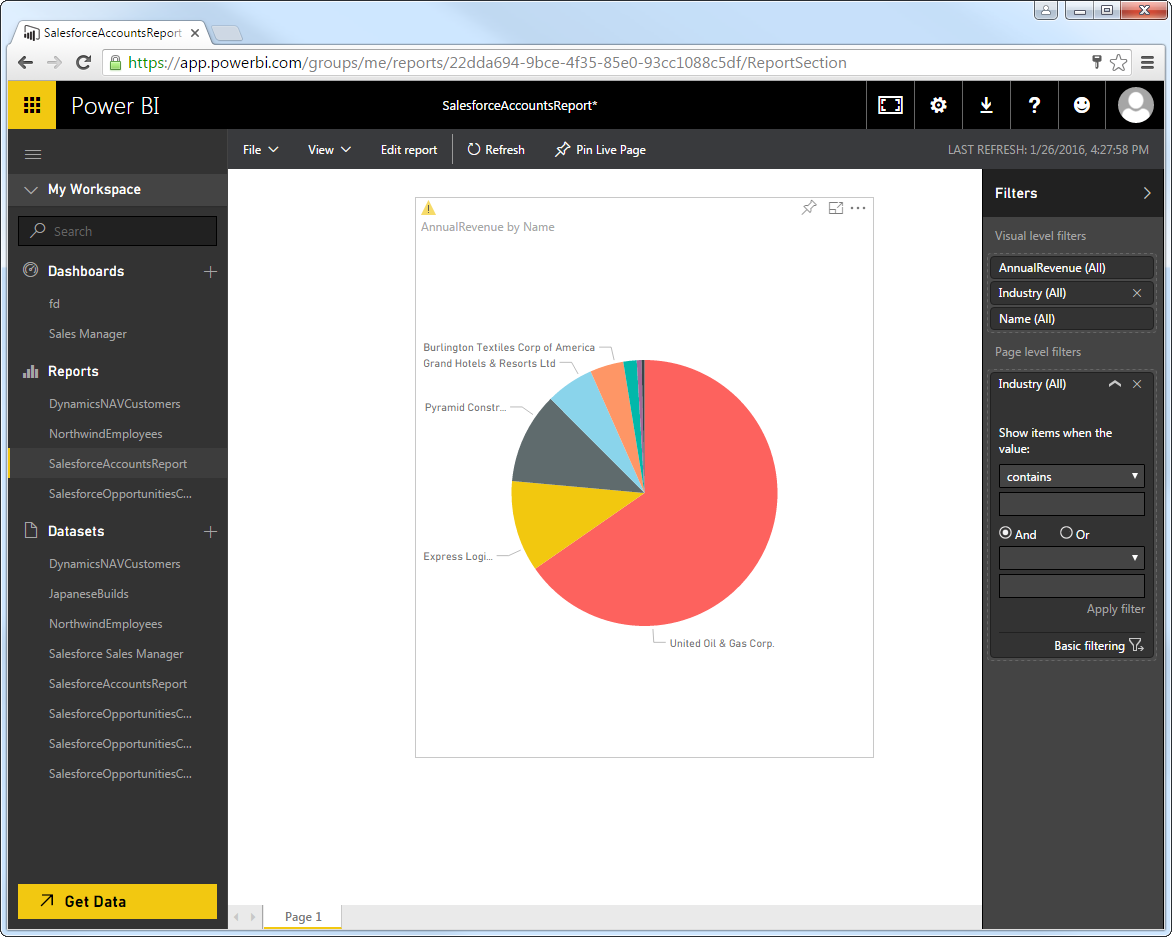Model Context Protocol (MCP) finally gives AI models a way to access the business data needed to make them really useful at work. CData MCP Servers have the depth and performance to make sure AI has access to all of the answers.
Try them now for free →How to Connect the Power BI Service to PingOne: Complete Guide
Connect to the CData Power BI Connectors from PowerBI.com to provide real-time datasets across the organization.
The CData Power BI Connector for PingOne seamlessly integrates with the tools and wizards in Power BI, including the real-time data workflows on PowerBI.com. Follow the steps below to publish reports to PowerBI.com and use the Power BI Gateway to configure automatic refresh.
1. Create a DSN
Installing the Power BI Connector creates a DSN (data source name) called CData Power BI PingOne. This the name of the DSN that Power BI uses to request a connection to the data source. Configure the DSN by filling in the required connection properties.
You can use the Microsoft ODBC Data Source Administrator to create a new DSN or configure (and rename) an existing DSN: From the Start menu, enter "ODBC Data Sources." Ensure that you run the version of the ODBC Administrator that corresponds to the bitness of your Power BI Desktop installation (32-bit or 64-bit).
To connect to PingOne, configure these properties:
- Region: The region where the data for your PingOne organization is being hosted.
- AuthScheme: The type of authentication to use when connecting to PingOne.
- Either WorkerAppEnvironmentId (required when using the default PingOne domain) or AuthorizationServerURL, configured as described below.
Configuring WorkerAppEnvironmentId
WorkerAppEnvironmentId is the ID of the PingOne environment in which your Worker application resides. This parameter is used only when the environment is using the default PingOne domain (auth.pingone). It is configured after you have created the custom OAuth application you will use to authenticate to PingOne, as described in Creating a Custom OAuth Application in the Help documentation.
First, find the value for this property:
- From the home page of your PingOne organization, move to the navigation sidebar and click Environments.
- Find the environment in which you have created your custom OAuth/Worker application (usually Administrators), and click Manage Environment. The environment's home page displays.
- In the environment's home page navigation sidebar, click Applications.
- Find your OAuth or Worker application details in the list.
-
Copy the value in the Environment ID field.
It should look similar to:
WorkerAppEnvironmentId='11e96fc7-aa4d-4a60-8196-9acf91424eca'
Now set WorkerAppEnvironmentId to the value of the Environment ID field.
Configuring AuthorizationServerURL
AuthorizationServerURL is the base URL of the PingOne authorization server for the environment where your application is located. This property is only used when you have set up a custom domain for the environment, as described in the PingOne platform API documentation. See Custom Domains.
Authenticating to PingOne with OAuth
PingOne supports both OAuth and OAuthClient authentication. In addition to performing the configuration steps described above, there are two more steps to complete to support OAuth or OAuthCliet authentication:
- Create and configure a custom OAuth application, as described in Creating a Custom OAuth Application in the Help documentation.
- To ensure that the driver can access the entities in Data Model, confirm that you have configured the correct roles for the admin user/worker application you will be using, as described in Administrator Roles in the Help documentation.
- Set the appropriate properties for the authscheme and authflow of your choice, as described in the following subsections.
OAuth (Authorization Code grant)
Set AuthScheme to OAuth.
Desktop Applications
Get and Refresh the OAuth Access Token
After setting the following, you are ready to connect:
- InitiateOAuth: GETANDREFRESH. To avoid the need to repeat the OAuth exchange and manually setting the OAuthAccessToken each time you connect, use InitiateOAuth.
- OAuthClientId: The Client ID you obtained when you created your custom OAuth application.
- OAuthClientSecret: The Client Secret you obtained when you created your custom OAuth application.
- CallbackURL: The redirect URI you defined when you registered your custom OAuth application. For example: https://localhost:3333
When you connect, the driver opens PingOne's OAuth endpoint in your default browser. Log in and grant permissions to the application. The driver then completes the OAuth process:
- The driver obtains an access token from PingOne and uses it to request data.
- The OAuth values are saved in the location specified in OAuthSettingsLocation, to be persisted across connections.
The driver refreshes the access token automatically when it expires.
For other OAuth methods, including Web Applications, Headless Machines, or Client Credentials Grant, refer to the Help documentation.
2. Get PingOne Data
With the data source configured, follow the steps below to load data from PingOne tables into a dataset.
Select Views to Load
- Open Power BI Desktop and click Get Data -> CData PingOne.
- Select CData Power BI PingOne in the Data Source Name menu and select the Import data connectivity mode.
- Expand the CData Power BI PingOne folder, expand an associated schema folder, and select tables.

Shaping Data
Use the Query Editor if you need more control over the query and query results before you load the data. Power BI detects the column behavior from the PingOne metadata retrieved by the CData connector. In the Query Editor, you can perform actions like filtering, summarizing, and sorting on columns.
To open the Query Editor, click Edit in the Navigator window. Right-click a row to filter the rows. Right-click a column header to perform actions like the following:
- Change column data types
- Remove a column
- Group by columns
Power BI records your query modifications in the Applied Steps section, adjusting the underlying data retrieval query that is executed to the remote PingOne data.
Load Data
When you click Load, the connector executes the underlying query to PingOne.
3. Create Data Visualizations
After loading PingOne data into Power BI, you can create data visualizations in the Report view by dragging fields from the Fields pane onto the canvas. Follow the steps below to create a pie chart:
- Select the pie chart icon in the Visualizations pane.
- Select a dimension in the Fields pane: for example, Id.
- Select a measure in the Fields pane: for example, Username.

You can change sort options by clicking the ellipsis (...) button for the chart. Options to select the sort column and change the sort order are displayed.
You can use both highlighting and filtering to focus on data. Filtering removes unfocused data from visualizations; highlighting dims unfocused data. You can highlight fields by clicking them:

You can apply filters at the page level, at the report level, or to a single visualization by dragging fields onto the Filters pane. To filter on the field value, select one of the values that are displayed in the Filters pane.

Click Refresh to synchronize your report with any changes to the data.
4. Configure Data Refresh on PowerBI.com
Follow the steps below to configure automatic data refresh through the Power BI Gateway. The gateway enables the Power BI cloud service to connect to the DSN on your machine.
Selecting a Gateway Mode
You need to select a gateway mode when you install the gateway:
- Gateway (personal mode): Use the gateway in personal mode if you only need to publish to PowerBI.com and refresh reports. The gateway runs under your Windows user account.
- (Recommended) Gateway (Standard mode - formerly Enterprise): Use the gateway in standard mode if you are using other Azure services that require a gateway. You also need the default gateway if multiple users need to access the gateway.
You need a system DSN to connect through the default gateway. (System DSNs can be accessed system-wide, while user DSNs can only be used by a specific user account.) You can use the CData Power BI PingOne system DSN configured as the last step of the connector installation.
Configuring the Gateway (Personal Mode)
Publishing through the gateway in personal mode simply requires an installed gateway with access to custom connectors.
- Run the CData Power BI Connector installer. If you have not already done so, download the Power BI Gateway.
- Select the on-premises data gateway (personal mode) option.
- Sign into the gateway.
- Name the gateway and specify a recovery key.
- In the Connectors section of the gateway settings, enable the custom data connectors option. You can also specify an alternate path to the custom data connector .pqx files here.
Note: The CData Power BI Connectors install the .pqx files to the default folder, Your User Home\Documents\Power BI Desktop\Custom Connectors.
Configuring the Gateway (Standard Mode)
Publishing through the gateway requires an installed gateway with access to customer connectors and a configured connection to the DSN for PingOne from PowerBI.com
1. Set Up the Gateway
Follow the steps below to configure the gateway on your machine:
- Run the CData Power BI Connector installer. If you have not already done so, download the Power BI Gateway.
- Select the on-premises data gateway (recommended) option.
- Sign into the gateway.
- Name the gateway and specify a recovery key.
In the Connectors step, choose a folder where the gateway will look for the CData Power BI Connector. This article uses C:\Users\PBIEgwService\Documents\Power BI Desktop\Custom Connectors\. Copy the .pqx files for the CData Connector (found in C:\Users\USERNAME\Documents\Power BI Desktop\Custom Connectors\) to the folder you configured.
NOTE: The account configured for the service (NT SERVICE\PBIEgwService) needs to be able to access the folder chosen for the gateway. If needed, you can change the service account in the Service Settings section of the gateway installer.
- Confirm that the entry CData.PowerBI.PingOne is displayed in the list in the Connectors section.

2. Connect to PingOne Data from PowerBI.com
- Add a data source to the gateway: Log into PowerBI.com and from the Settings menu, select Manage Gateways and select your gateway.
- Select the option to "Allow user's custom data connectors to refresh through this gateway cluster."
- Click Apply to save your changes.
- Click the option to add a data source to the gateway.
- In the Data Source Settings section, enter a name for the data source and in the Data Source Type menu select CData Power BI Connector for PingOne.
- In the Data Source Name box that is displayed, enter the system DSN: CData Power BI PingOne.
5. Publish to PowerBI.com
You can now publish refreshable reports and their underlying datasets. Follow the steps below to publish and complete the data refresh configuration for a dataset.
- In Power BI Desktop, click Publish on the Home ribbon to publish the report.
- On PowerBI.com, select the workspace where you uploaded the report.
- In the Datasets section, click the options menu for the PingOne dataset you created, then click Settings.
- In the Gateway Connection section, enable the option to use a gateway and select your gateway. You may need to manually add the data source to the gateway:
- Expand the Gateway under the Actions column
- Click the link to "Manually add to gateway"

- In the "New connection" form, set the Connection name, set Data Source Name to the same data source name as above (e.g. "CData PBI PingOne"), and set Authentication Method to "Anonymous"

- Set Privacy Level as needed and click "Create"
- If you are using the gateway in personal mode, expand the Data Source Credentials node and click Edit Credentials -> Sign In. (This step is not necessary if you are using the default gateway.)
6. Refresh a Dataset
Refresh the dataset to provide the current data to your reports.
- To refresh manually, open the dataset options menu from your workspace -> Datasets and click Refresh Now.
- To schedule refreshes, open the dataset options menu from your workspace -> Datasets and click Schedule Refresh. Enable the option to keep your data up to date. Specify the refresh frequency in the menus.
- In Report view, click Refresh to sync the report with the dataset as you work.

